
Making the Emergency Department More Accessible for Visually Impaired Patients
Key Takeaways
- Visually impaired patients face increased risks in EDs, including falls and complications, necessitating access to assistive devices and proper identification of impairments.
- Effective communication strategies, such as clear introductions and tailored informed consent, are crucial for visually impaired patients in EDs to ensure safety and autonomy.
Patients with visual impairments face major physical and financial barriers when seeking emergency care.
Emergency departments (EDs) are often the frontline of health care, addressing urgent and life-threatening cases. However, for patients who are
Physical Barriers
Navigating the physical environment of the ED is a major challenge for visually impaired patients, who are more likely to experience in-hospital complications such as falls, delirium, and extended hospital stays.1 Falls are a particularly common reason for ED visits among this population, with sequelae like fractures often leading to hospital admissions. Children with visual impairments are also at increased risk for orthopedic injuries, further highlighting the physical vulnerability of this group.
To mitigate these risks within the ED itself, recommendations published in the
Researchers said the best time to note visual impairment is right at the beginning during the intake or triage process, and it should be noted in the patient's chart and/or wristband so that providers at all points during the ED visit can quickly adjust care if needed, thus streamlining communication on the provider end and minimizing patient stress. However, it is still important to respect the patient’s boundaries and ask for consent.
“Very rarely do people know to say, ‘I’ve noticed that you seem to be vision impaired,’ or ‘I’ve noticed that you’re using a cane; would you like a human guide?’” said a participant from
While ADA guidelines help ensure that patients can physically navigate the ED, there is limited research on how to make these facilities more accessible beyond the requirements.
“The lack of research investigating the ED experiences of those living with disabilities represents a large gap in understanding between ED staff and these patient populations, which comprise a significant number of ED visits each year nationwide,” researchers wrote.
Communication Barriers
Communication remains another major barrier for visually impaired patients; if communication is inadequate, it can make the patient feel disoriented and excluded during their own care.1 According to researchers, this can be combatted with simple strategies like introducing staff when entering and exiting the room and providing clear explanations of each step in the care process. Informed consent should also be tailored for visually impaired patients, as they may need extra details communicated to them throughout the visit.
“Adding this extra layer of communication can be instrumental in ensuring patient safety and adherence, and the overall efficacy of the medical intervention for blind patients,” researchers wrote. “Furthermore, it serves to maintain respect for their autonomy, helps foster a cooperative environment, and minimizes surprise or discomfort during the procedure, a particularly important consideration in an ED setting where the pace of care is often rapid and potentially anxiety-inducing”
Hospitals are also encouraged to provide discharge education through accessible technologies such as screen readers or electronic documents so patients have the information they need to understand their care and follow-up plans.2 Noting there are several areas for improvement in ED accessibility, researchers also found that some patients reported feeling “ostracized” and “insulted” after requesting accommodations from staff.
“This finding is not unique to the ED, as prior research has found that even when accessible medical equipment is available, healthcare personnel are still hesitant to use it,” they wrote. “Thus, it is important that any equipment or technology provided to improve accessibility be paired with healthcare worker training that enables personnel to feel comfortable using the equipment.”
Cost Barriers
Outside of emergency care, patients with visual impairments face health care costs every day. Aside from any necessary glasses or transportation, other hidden costs may include screen readers, guide animal care, or home care, for example.
Altogether, the average annual cost of living with blindness is $16,838 per person, according to research published in
Vision rehabilitation and medical expenses such as eyeglasses, contact lenses, and home health care accounted for significant direct costs. Most of these costs were due to nursing home care, which accounted for $41.8 billion, followed by other medical care ($30.9 billion) and reduced labor force participation ($16.2 billion), the last of which accounted for 46% of all indirect expenses on its own.
“Unlike prior studies, our estimates do not include costs of vision or eye-related services among people without [vision loss], which would capture the cost of eye disorders that do not or have not yet caused [vision loss],” researchers wrote. “This narrower perspective is responsible for the lower topline estimate, as compared with earlier work.”
The lack of preventive care access poses another challenge. Data showed that patients in states without Medicaid expansion were more likely to rely on the ED for primary health care needs, which increases costs for both patients and health care systems. With this in mind, the authors encouraged Americans to advocate for Medicaid expansion in their state.
References
- Hamadah K, Velagapudi M, Navarro JJ, Pirotte A, Obersteadt C. Best practices for treating blind and visually impaired patients in the emergency department: a scoping review. West J Emerg Med. 2024;25(3):350-357. doi:10.5811/westjem.61686
- Carmichael JH, Kalagher KM, Reznek MA, Modi P. Improving accessibility in the emergency department for patients with disabilities: a qualitative study. West J Emerg Med. 2023;24(3):377-383. doi:10.5811/westjem.58406
- ADA requirements: service animals. ADA. Updated February 28, 2020. Accessed January 21, 2025. https://www.ada.gov/resources/service-animals-2010-requirements/
- Rein DB, Wittenborn JS, Zhang P, et al. The economic burden of vision loss and blindness in the United States. Ophthalmology. 2022;129(4):369-378. doi:10.1016/j.ophtha.2021.09.010
Newsletter
Stay ahead of policy, cost, and value—subscribe to AJMC for expert insights at the intersection of clinical care and health economics.








































